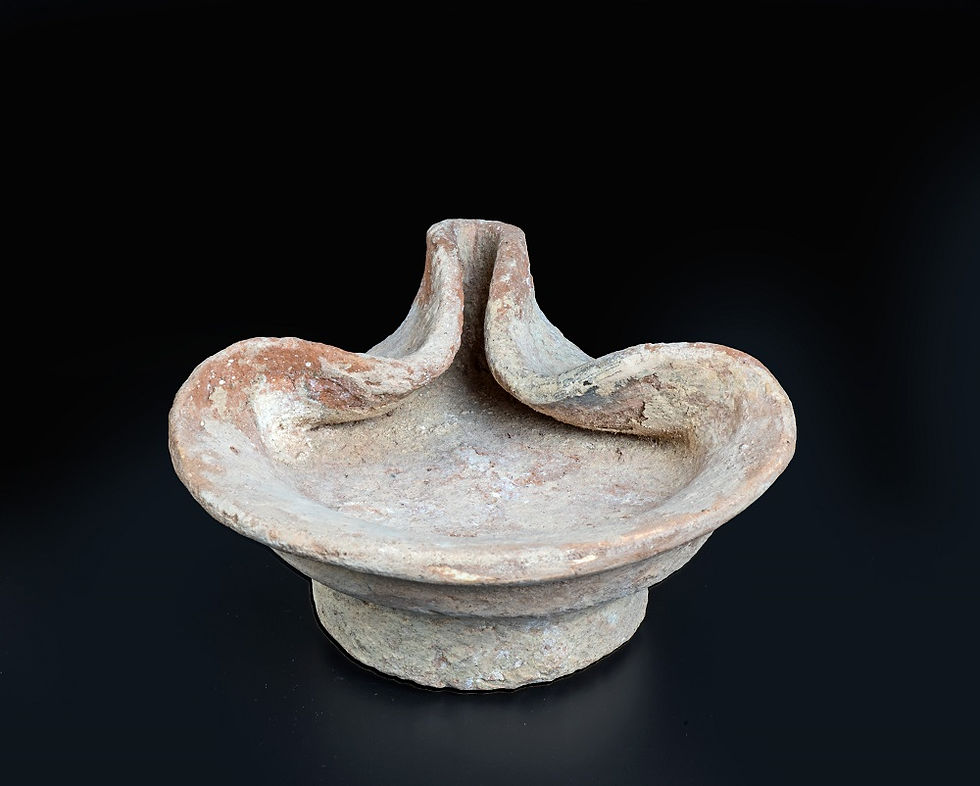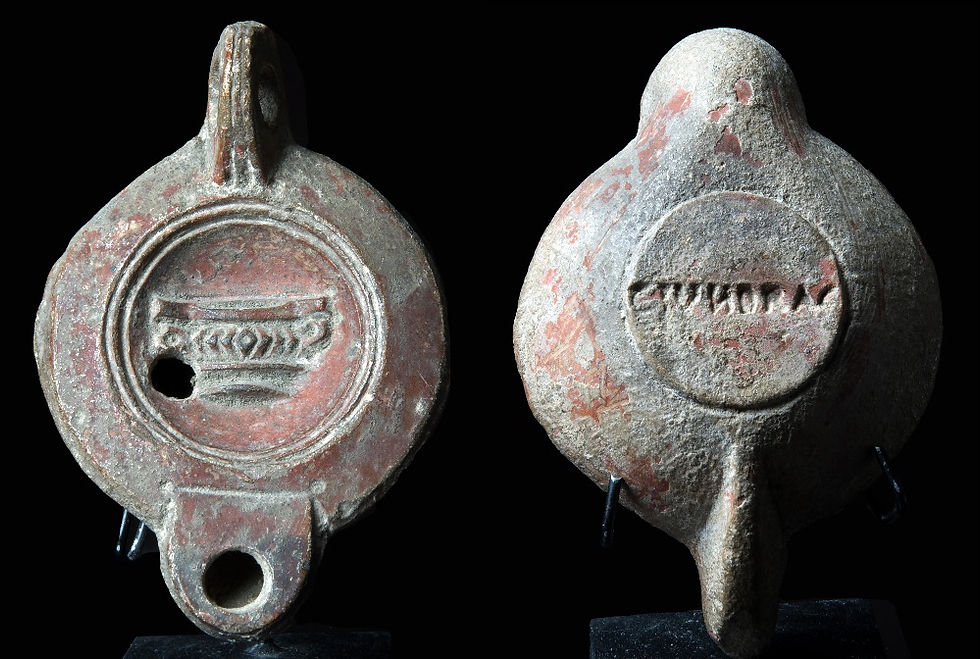Lighting up antiquity - themes for collecting oil lamps
- Times Ancient
- Feb 18, 2022
- 7 min read
Updated: Nov 17, 2023
The simple technology of oil and wick in a vessel was used throughout the World from pre-historic times. Pottery lamps were ubiquitous in classical antiquity, reaching their peak of production in the Roman era. With so many manufactured, and indeed so many still surviving, what makes them collectable?
We look here at a few features and themes that make oil lamps attractive to collectors, focusing on examples from the Mediterranean region.
Some of the lamps featured below are for sale at time of posting. SHOP NOW
GENERAL FEATURES
Small, affordable, documented
As with other collectable items such as ancient coins, size matters. Small, portable objects are simply more practical for collectors to acquire, store, display and pass on. While oil lamps come in a variety of shapes and sizes, most are no more than few inches in diameter. Availability means that many oil lamps are affordable enough that it is possible to build an interesting collection without laying out a fortune. The types and development of oil lamps has been well documented in the archaeological/collection record, providing good reference information if you research across publications and collections. Lamps have proved useful to archaeologists for dating and trading evidence.
By popular demand
Unlike ancient coins from antiquity, which were usually controlled by the state in design and manufacture, makers of oil lamps were mostly free to design according to their own preferences, and of course those of their customers. This makes them indicators of trends and popular taste of ordinary people in the form and decoration of these everyday objects for the masses.
The appeal of everyday objects
We are moved by the objects of daily life: a mirror that a South Italian beauty once used to arrange her hair, a glass perfume bottle that adorned a Roman matrons table, a humorous terracotta lamp that gave light to some ancient insomniac.
The J. Paul Getty Museum in assoc. with the Cleveland Museum of Art, A passion for antiques: Ancient Art from the collection of Barbara & Lawrence Fleischman, 1994 p. vii
The simple circular symmetry of these little lamps is highly pleasing in itself. The presence of the human hand is tangible in their manufacture by wheel or mould, with the sculpting of lip or spout; but also in their function as lamps to be carried in the palm of the hand or between thumb and finger. They often still bear signs of fire or heat, a direct connection to their last use in ancient times, perhaps in a home providing comfort and ambience, perhaps in a commercial, religious or funerary context.
Such lamps can be very attractive small objects and well repay attention. They are of interest to the social and art historian because of the representations of daily life, religion and mythology, and of lost masterpieces of sculpture appearing on some Roman lamps.
DM Bailey, Greek and Roman pottery lamps, British Museum, 1972 Introduction
CULTURE
Bronze Age, Iron Age, Greek/Hellenistic, Roman, Byzantine, with period, regional and provincial variations - the list is long. Many types and styles within these broad cultures and ages are however identifiable and dateable with research. For the very keen collector, the fine detail of lamp characteristics have been extensively categorised and indexed, but research across publications and collections is needed.
Early lamps: saucer-type
The earliest pottery lamps were hand-made then wheel-made. Saucer-types, also called shell or cocked hat, are generally simple and undecorated, taking the form of either a bowl or saucer with one or more pinched lip to form a wick rest or hole. They are attractive in their simplicity, functionality and obvious working by the human hand. The dominant type was a saucer with one pinched corner, a form that lasted for more than two thousand years. (Bussière & Wohl 2017 p.8 citing Rosenthal & Sivan 1978, p.76).
By the end of the second century B.C. the long life of the saucer type came to an end.
J Bussière, BL Wohl; Ancient Lamps in the J. Paul Getty Museum; 2017, p.8
Greek and Hellenistic lamps
In the Greek era the main developments were that lamps were more closed, presumably to reduce spillages and evaporation, with bridged nozzle to help control the wick and flame. They were wheel-made, round, gradually getting deeper with longer nozzles. Slip glazing also occurred by painting and pouring slip while the lamp was being turned, primarily to reduce permeability, but also applied decoratively.
During the 6th, 5th and 4th centuries B.C., and probably somewhat later, Athens appears to be the major producer of new types, and these high-quality lamps were exported all over the Mediterranean and Black Sea ...
DM Bailey, Greek and Roman pottery lamps, British Museum, 1972 p. 17
Mould-made lamps from clay moulds began to appear in the early 3rd century BC, produced particularly in the eastern Mediterranean, such as at Ephesus (Bailey, 1972), but it was the Romans who took it to the next level using plaster moulds.
Roman advancement in technology, design and output
During the late first century B.C. and the early 1st century A.D., the new Italian shapes swamped the market, were exported everywhere, and were copied by provincial workshops. These lamps, with their voluted nozzles, both round and angular ... and allowing the employment of a large area for decorative relief pictures, were, at their best, among the finest mould-made lamps ever produced.
DM Bailey, Greek and Roman pottery lamps, British Museum, 1972 p 18
Factory lamps
In mid 2nd century AD northern Italy emerged the peak of mass-production in the form of what we know as factory lamps or firmalamps, particularly popular in Italy and the north-west provinces, dominating production and consumption in these areas. They are of simpler, of more consistent designs and usually bear a maker's mark.

Frog lamps
In the 3rd-4th century AD, in Egypt, a particular form known as the frog lamp proved popular. While some finer examples show a complete frog, most have just part of the frog's body. The frog symbolised fertility and renewal in Ancient Egypt, emerging every year in abundance from the marshes of the Nile.
Holy Land lamps from around the time of Jesus
Into the Byzantine era
From the 4th century AD, production of oil lamps disappeared in the north west provinces, but continued for centuries in eastern areas of the Mediterranean, such as red slip lamps from North Africa and slipper lamps from the Levant, with their own characteristic forms. Christian and Jewish symbols also increasingly appeared on lamp decoration from this time.

DECORATIVE THEMES
The concave upper surface of the Roman closed lamp is known as the discus, and provided room for an array of decorative reliefs, made possible by the technology of plaster moulding. As well as linear and geometric shapes, they included deities, mythical scenes, animals and flora, depictions from daily life and leisure such as chariot racing, gladiators, theatre and other entertainments, work, domestic objects and erotic scenes. All are fascinating indicators of the preoccupations of life, culture, fashion and popular pursuits across the Roman world, and provide a wealth of themes for collectors to focus on.
Animals, usually shown singly, but sometimes in groups, such as hounds attacking deer, are found on a great many relief lamps. Domestic and wild animals, birds, fish, shellfish and insects are all represented.
DM Bailey, Greek and Roman pottery lamps, British Museum, 1972 p23
Actors performing, and the many examples of masks on lamps reflect the popularity of the play, and other entertainments illustrated include jugglers, performing animals, boxers and tightrope walkers.
DM Bailey, Greek and Roman pottery lamps, British Museum, 1972 p22
MAKERS' MARKS
Makers' marks are a great focus for collecting and appreciating Roman lamps in particular. Good research can identify both well-known and rarer manufacturers, sometimes revealing the exact time and location of a workshop's activity.
Caius Oppius Restitutus was either potter or owner of a prolific workshop producing many types of lamps, probably near Rome, from late Flavian to early Antonine period, circa 80-160 AD. (https://www.britishmuseum.org/collection/term/BIOG59704)
C Junius Draco is a well-known North African maker operating between 120-200 AD and would probably have had a large export trade. His mark was CIVNDRAC. (https://www.britishmuseum.org/collection/term/BIOG58965 )
Quintus Justus:

... the Justus family was very well-known for its lamp making during the first and second centuries. Two branches of the family are distinguishable based on the signatures of two of their respective members: the first of these signed his works IVSTI (Justus); the second used the tripartite name form MNOVIVST (M. Novius Justus). ... both were probably located close to El Djem.
Anna Manzoni Macdonnell. “An Egotistical Lamp Maker from El Djem.” The J. Paul Getty Museum Journal, vol. 12, J. Paul Getty Trust, 1984, pp. 141–44, http://www.jstor.org/stable/4166512.
Two of the most prolific makers of factory lamps were Strobilus and Fortis, both of whose lamps are regularly available on the ancient artifacts market.
Strobilus was active in the area of modern Modena, Italy.
Strobilus has been regarded as the possible inventor of the Firmalampe (factory lamp) and was certainly one of the earliest makers of this type.
Ancient Lamps: http://www.romulus2.com/lamps/database/lamp.php?144

References and further information
DM Bailey, Greek and Roman pottery lamps, British Museum, 1972
DM Bailey, A Catalogue of the Lamps in the British Museum, vol. II, 1980
J Bussière, BL Wohl, Ancient Lamps in the J. Paul Getty Museum, 2017
S Djuric, The Anawati Collection: Ancient Lamps from the Mediterranean, Eika, 1995
J. Paul Getty Museum in assoc. with the Cleveland Museum of Art, A passion for antiques: Ancient Art from the collection of Barbara & Lawrence Fleischman, 1994 p. vii
JW Hayes, Ancient Lamps in the Royal Ontario Museum I: Greek and Roman Clay Lamps, Royal Ontario Museum, 1980
AM Macdonnell. “An Egotistical Lamp Maker from El Djem.” The J. Paul Getty Museum Journal, vol. 12, J. Paul Getty Trust, 1984, pp. 141–44
R Rosenthal, R Sivan, Ancient Lamps in the Schloessinger Collection, 1978
Some of the lamps featured above are for sale at time of posting.

















Kommentare